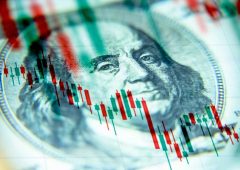U.S. PPI Shows Inflation Cooling, But Trade Policies May Disrupt Progress
14.01.2025 16:51 1 min. read Alexander Zdravkov
Wholesale inflation in the U.S. showed signs of easing in December, offering a glimmer of hope that price pressures may not be accelerating as feared.
The Producer Price Index (PPI), which tracks changes in prices paid to producers, edged up by just 0.2% for the month and 3.3% year-over-year, falling slightly below economists’ expectations.
Energy costs were the primary factor behind the monthly increase, with wholesale energy prices jumping 3.5%. This rise offset otherwise stable pricing trends, as core PPI—excluding the more volatile food and energy categories—remained unchanged from November and held steady at 3.5% annually.
Economist Chris Rupkey of FwdBonds cautioned against celebrating too soon, warning that potential trade policies under President-elect Donald Trump could disrupt inflation trends. Proposed tariffs on key trading partners could lead to higher import costs, ultimately affecting consumer prices. Rupkey suggested that future inflation would largely depend on how these policies unfold, describing the current data as “a small victory” in a larger, uncertain battle.
While December’s inflation figures marked a slowdown compared to November’s 0.4% monthly rise, which was partly driven by soaring egg prices, they still represent the highest annual increase in PPI since February 2023. The slightly cooler-than-expected numbers bring temporary relief, but with economic uncertainty looming, analysts remain cautious about what lies ahead for inflation trends.
-
1
U.S. PCE Inflation Rises for First Time Since February, Fed Rate Cut Likely Delayed
27.06.2025 18:00 1 min. read -
2
Billionaire Slams Meme Stock Hype and Sounds Alarm on U.S. Fiscal Health
15.06.2025 18:00 2 min. read -
3
Robert Kiyosaki Predicts 2025 “Super-Crash,” Urges Hoarding Gold, Silver, and Bitcoin
23.06.2025 13:31 2 min. read -
4
Billionaire Investor Sees Dollar Crash If Key Support Breaks
18.06.2025 15:00 1 min. read -
5
Nassim Taleb Says Global Trust Is Shifting from the Dollar to Gold
22.06.2025 17:00 1 min. read
U.S. PCE Inflation Rises for First Time Since February, Fed Rate Cut Likely Delayed
Fresh data on Personal Consumption Expenditures (PCE) — the Federal Reserve’s preferred inflation gauge — shows inflation ticked higher in May, potentially delaying the long-awaited Fed rate cut into September or later.
Trump Targets Powell as Fed Holds Rates: Who Could Replace Him?
Federal Reserve Chair Jerome Powell is once again under fire, this time facing renewed criticism from Donald Trump over the Fed’s decision to hold interest rates steady in June.
U.S. National Debt Surge Could Trigger a Major Crisis, Says Ray Dalio
Billionaire investor Ray Dalio has sounded the alarm over America’s soaring national debt, warning of a looming economic crisis if no action is taken.
Recession Fears Linger as Economic Signal Flashes Long-Term Warning
Despite a recent shift in sentiment suggesting the U.S. economy might dodge a recession, key forecasting tools are telling a different story.
-
1
U.S. PCE Inflation Rises for First Time Since February, Fed Rate Cut Likely Delayed
27.06.2025 18:00 1 min. read -
2
Billionaire Slams Meme Stock Hype and Sounds Alarm on U.S. Fiscal Health
15.06.2025 18:00 2 min. read -
3
Robert Kiyosaki Predicts 2025 “Super-Crash,” Urges Hoarding Gold, Silver, and Bitcoin
23.06.2025 13:31 2 min. read -
4
Billionaire Investor Sees Dollar Crash If Key Support Breaks
18.06.2025 15:00 1 min. read -
5
Nassim Taleb Says Global Trust Is Shifting from the Dollar to Gold
22.06.2025 17:00 1 min. read


